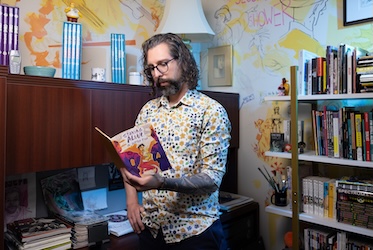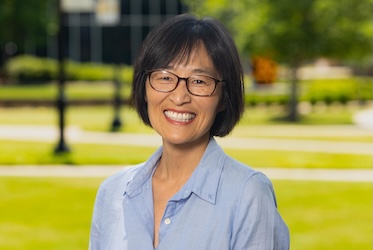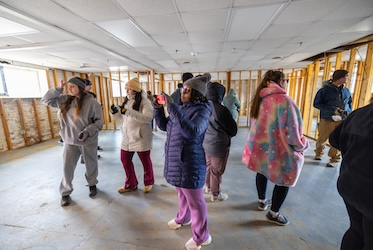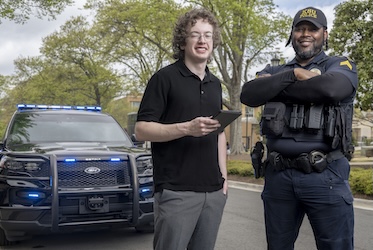
VIP program supports large-scale, interdisciplinary research teams
KENNESAW, Ga. | Feb 18, 2022
Kennesaw State University has joined the ranks of institutions nationwide and internationally to transform the way research and education can be strategically integrated into the undergraduate curriculum. The Office of Undergraduate Research recently launched a Vertically Integrated Projects (VIP) program, designed to facilitate long-term projects involving large interdisciplinary teams of faculty and students.
The VIP model builds on existing faculty members research interests and efforts that can be scaled up to address even bigger challenges in their fields. Students gain valuable research skills and earn academic course credit through their participation. The VIP program was founded by Ed Coyle, director of the VIP Consortium, of which KSU is a member and which includes a total of 43 institutions based in 16 states and 12 countries. KSU is the first to offer the program through a centralized undergraduate research office.
“We are excited to bring this well-known program to KSU,” said Amy Buddie, director of undergraduate research. “The VIP program broadens student participation across all disciplines, backgrounds and skill levels. In this way, we are increasing accessibility of undergraduate research opportunities at all levels, especially for underrepresented minorities.”
Six VIP teams have been established for this inaugural year, with three of them highlighted in the following vignettes to show the transformative effect taking place at KSU.
Building an Interdisciplinary Research Team
When Cyril Okhio, assistant professor of electrical engineering, first heard about the VIP program, he believed that this initiative would help jump-start the development of an interdisciplinary research laboratory in engineering, computing and technology. The new lab would focus on studying brain activity of subjects engaged in immersive visualization environments generated by specially designed computer tools and programs. Okhio assembled a group of eight undergraduates and eight faculty members, spanning the disciplines of engineering, nursing, psychology, physics, biology and information systems.

“This was the opportunity we needed to bring our ideas to fruition with some of the seed funding provided by the VIP program for the first year,” Okhio said. “We are excited about the prospect of creating the first engineering-related electroencephalogram (EEG) experimental lab in the Southern Polytechnic College of Engineering and Engineering Technology.”
Sumit Chakravarty, associate professor of electrical engineering, was one of the first researchers Okhio approached. Chakravarty’s primary motivation for joining the team was the potential to devise research questions on brain-computer interactions from a variety of perspectives, most notably the reinforcement of learning engineering concepts and enhancing attention.
“A research group keeps you engaged in your one area of expertise, but a VIP team allows you to brainstorm and synergize, sometimes stepping out of your comfort zone. That is very liberating,” said Chakravarty, whose interests focus on signal processing and artificial intelligence applications.

Planned research activities include using 3D content development tools to create lesson plans for the study of attention and using EEG tools and associated software environments to analyze visual scenarios of human perceptions and create necessary rewards for the reinforcement of learning-based training.
Tim Martin, team member and associate professor of psychology, envisions his role as advisor since his specialty is in cognitive science with experience in brain imaging. “The potential for this kind of collaboration is astronomical in terms of changing how we teach material and how we convey the emotional content of abstract intellectual information,” he said.
Scaling Up for Long-Term Results
Giovanni Loreto, assistant professor of architecture, is always seeking ways to challenge his undergraduates. What started out as a class assignment in finding a more sustainable, low-cost approach in the production of concrete structures just a few years ago has morphed into a full-fledged VIP team.
The nine undergraduates and four faculty advisors come from the fields of architecture, civil engineering and mechanical engineering. They are focused on using nonrigid formwork systems, permanent or temporary molds into which concrete is poured, that optimizes structural elements to reduce the amount of concrete needed to carry loads in buildings.

“Innovation in structural engineering and architectural design seems to move at a slow pace compared to other branches of engineering,” said Loreto. “The reason is in twofold. From one side, we are dealing with massive objects in terms of weight and size. On the other hand, we design objects that need to be functional for hundreds of years. The VIP approach allows me to scale up the scope of the research while providing students the opportunity to reach out to the appropriate experts at each stage of development of their research.”
For architecture major Moritz Meditz, the opportunity to oversee the design, construction and testing of these formwork systems is one of the best ways he can prepare for his career in architecture.
“I was super excited since this research project relates directly to my thesis and will allow me to take a more practical approach rather than a pure academic one, typical for architecture thesis projects,” said Meditz, who plans to pursue a master’s degree after graduating next May.
Civil engineering major Sean Sadler was first introduced to this research as a First-Year Scholar, another initiative of the Office of Undergraduate Research, which introduces first-year students to the research process.
“I am still a sophomore, so I am not fully decided on my career goals; however, I know that I would like to continue working on research at least while I am an undergraduate,” said Sadler, who is now in a leadership role on the VIP team.
Creating a Unique Mentorship Environment
Katherine Ingram, associate professor of exercise science, has the largest VIP team, composed of 10 undergraduates, two graduate students, two postdoctoral researchers and three additional faculty collaborators. The team is studying the effects of obesity and physical activity on maternal health, a three-year project funded last year by the National Institutes of Health’s Eunice Kennedy Shriver National Institute of Child Health and Human Development.

“One of the significant characteristics of our team is that it is highly interdisciplinary,” said Ingram. “And through this interdisciplinary collaboration, we see the opportunity for this program to grow in many dimensions.”
Ingram added that the VIP model was attractive for her because she was looking for
ways to expand the educational experiences for the undergraduates she was already
mentoring. Since the VIP structure emphasizes a system of mentorship at every level,
she said applying to the program was ideal in turning what she was already doing into
something more tangible and sustainable.

For graduate student Sophia Ramirez, participating on the team has increased her prowess and confidence as a mentor and mentee. She is pursuing a master’s degree in applied exercise and health sciences, with aspirations of becoming a surgeon.
“This system allows autonomy while connecting with senior students. It allows for a lot more freedom to learn and grow as a team,” she said. “This is an amazing experience to learn from, as there is always something to learn.”
Postdoctoral researcher Sadaf Dabeer adds that the VIP program is a unique opportunity for people at her career stage. “Postdocs who want to make a career in academia often do not get much experience in teaching methods and course development because they are too focused on research,” she explained. “VIP is special for us because we learn to mentor while we are being mentored. It’s a process of mutual uplift, and personally for me, it is very rewarding professionally and emotionally.”
– Joelle Walls
Related Stories

Kennesaw State professor uses experience to inspire art students

Kennesaw State professor earns Mid-Career Award from American Educational Research Association

Kennesaw State architecture, engineering students reimagine Asheville's devastated River Arts District

Kennesaw State student develops AI tools to help first responders diagnose behavioral health issues
A leader in innovative teaching and learning, Kennesaw State University offers undergraduate, graduate, and doctoral degrees to its more than 47,000 students. Kennesaw State is a member of the University System of Georgia with 11 academic colleges. The university’s vibrant campus culture, diverse population, strong global ties, and entrepreneurial spirit draw students from throughout the country and the world. Kennesaw State is a Carnegie-designated doctoral research institution (R2), placing it among an elite group of only 8 percent of U.S. colleges and universities with an R1 or R2 status. For more information, visit kennesaw.edu.















